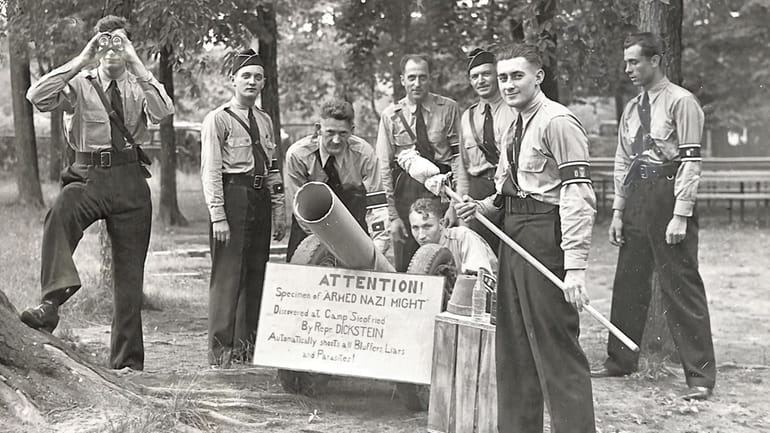Yaphank's Camp Siegfried featured in PBS' 'Nazi Town, USA,' chronicling rise, fall of German American Bund

In this scene from PBS' "Nazi Town, USA," uniformed members of the German American Bund pose at Yaphank Camp Siegfried. Credit: National Archives
Brooklyn-based filmmaker Peter Yost has produced several provocative films over the years for PBS ("Nova" and 2021's "Mysteries of Mental Illness") and National Geographic (2006's "Inside North Korea"). Now he's done his first "American Experience" outing: "Nazi Town, USA" (Tuesday at 9 p.m. on WNET/13).
In this hour film, Yost explores the roots and impact of the German American Bund, the late-1930s fascist organization headed by Fritz Kuhn, which established dozens of "youth camps" around the nation, including Camp Siegfried in Yaphank. It's a fascinating look at a group that burned hot — and burned out quickly too. Yost spoke recently with Newsday.
When did you first hear about the Bund?
A very close friend from college, and colleague, Marshall Curry, did a [Oscar-nominated 2018] film called "A Night at the Garden" — a short only about seven or eight minutes that looked exclusively at the [Feb. 20, 1939] German American Bund rally at Madison Square Garden. It was quite impactful because people were sort of shocked [wondering] how do you have this happening in America at this moment? I was kind of pulling at Marshall's sleeve and saying, if you can get 20,000 of these guys in Madison Square Garden at this particular moment, what the heck is going on in America? I wanted to provide the broader context for why these ideas resonated as much as they did for Americans at that time.
And what the heck was going on out on Long Island?
Yes, Camp Siegfried was the largest and it was very well-documented. They were quite serious and organized, and close to New York City, which was the national headquarters of the Bund, and where you also had the media. Some of [the dozens] of other camps were smaller and got less attention, but they all had similar goals, which were ultimately to indoctrinate a new generation to this [Nazi] ideology.
Siegfried did draw an enormous amount of media attention — as your film makes clear — but did that also distort the actual size of the Bund? Were they perhaps just an extreme fringe element in the country?
They probably punched beyond their weight as an organization. They were intentionally incendiary, often marching in front of Jewish people's homes in Manhattan and elsewhere around the country, and knew how to play to the press, so they drew a lot of attention. [But] the story we're telling is the story of America at this time, and what was it about the 1920s and 1930s that made the country so receptive to these far-right and fascist ideas. The Bund was one of probably hundreds of fascist-friendly groups that existed across the country, some of those very, very small.
What was going on, then?
This was a moment on the heels of the Great Depression where there was a great deal of fear, dislocation and turmoil. A significant number of people in America were seriously asking themselves whether the American experiment had failed, whether democracy itself had run its course, or whether it was time to turn to something else, whether on the left — communism — or on the right, fascism.
The reporter Dorothy Thompson (1893-1961) assumes a brief but vivid starring role in the film.
She was a female foreign correspondent in Europe and that alone back in that era was certainly something. She was an incredibly strong, intelligent woman and [angered] Hitler very early on by calling him a buffoon and calling out the dangers of his ideology. One of the first things Hitler did when he ascended to power was summarily kick her out of Germany and she wore that as a badge of honor the rest of her life. When she came back to America, she did the exact same thing with the Bund and other groups. At Madison Square Garden that night, she was kicked out once, and actually came back in and got kicked out again. She was resilient and brave in many ways.
The film is confined to the late '30s, but it's not too hard to find modern-day parallels, right?
It was sobering to see how at the time members of the Bund and others blamed Jews for being communists, while at the same time, Henry Ford and others thought that they were pulling the strings of Big Capital. So it was a one-size-fits-all scapegoating, and there was almost no recognition of the cognitive dissonance of that. I do feel there are echoes of that today. It's like in every era — whatever bill needs to be fit, [Jews] fit the bill.
